Federal Law
-
- Marine Casualty Reporting: Addressing the Coast Guard's Processes Maritime Reporter, Jun 2015 #16
The United States marine casualty reporting and investigation processes as administered by the U.S. Coast Guard are seriously flawed and in need of major overhaul.
These processes have been broken for years, yet minimal efforts have been made to address the root causes. The Coast Guard is drowning in marine casualty reports. The majority of its informal investigations are never closed. Those that are closed are seldom read again. Lessons that might have been learned from marine casualties are rarely shared with the maritime industry. It is time to go back to basics. Why does the Coast Guard require the reporting and investigation of marine casualties?
It’s the Law
Federal law directs the Coast Guard to prescribe regulations on the marine casualties to be reported and the manner of reporting. Marine casualties involving death, serious injury, material loss of property, material damage affecting the seaworthiness or efficiency of a vessel, or significant harm to the environment are defined by law as reportable casualties. Federal law also directs the Coast Guard to prescribe regulations for the immediate investigation of marine casualties to determine, to the extent possible, the cause of the casualty; whether there was any misconduct or negligence that might result in any action against a seafarer’s document or license or the assessment of a civil penalty; or whether there is need for new or amended laws or regulations.
The International Convention on Safety of Life at Sea (SOLAS Convention) provides that each Administration undertakes to conduct an investigation of any casualty occurring to any of its ships subject to the Convention when it determines that such an investigation is appropriate. The Casualty Investigation Code was adopted in 2008 to provide guidance to Administrations in the conduct of such marine casualty investigations.Thus, federal law and the IMO Casualty Investigation Code provide the foundations for the Coast Guard’s marine casualty investigation program. These two foundations are outside the ability of the Coast Guard to effect unilateral changes, but they also provide the Coast Guard with broad discretion in how those foundational requirements are implemented.
Given that the Coast Guard’s ability to consistently implement and enforce its current marine casualty reporting and investigation processes is over-taxed, I recommend that the Coast Guard cease this endless suffering from self-inflicted wounds and reduce the program to its foundational requirements.
Regulations promulgated by the Coast Guard include a very detailed, extensive, and confusing definition of “marine casualty or accident” along with a separate (but no less detailed, extensive, and confusing) definition of marine casualties that must be reported to the Coast Guard. The regulations further provide that, upon receipt of information of a marine casualty or accident, the Commandant or District Commander will immediately order such investigation as may be necessary. Coast Guard guidance, policy, and tradition basically require that each reported marine casualty be investigated, although there are different levels of investigation, depending upon the severity of the casualty.These reporting and investigation regulations are the root cause of the current problems with the Coast Guard’s marine casualty program. The regulations require the reporting and investigation of many more incidents than are provided for (or contemplated) in either federal law or the SOLAS Convention.
Amending the Law
The reporting regulations should immediately be amended to reduce the requirements, particularly with regard to personal injury and property damage. There are many minor injuries necessitating more than first aid (such as a sprained ankle) that should not require a marine employer to file a report with the federal government. The current property damage provision (any damage exceeding $25,000) is ridiculous. Very little damage on a commercial vessel can be repaired for that amount today. In addition, how is a master to determine the cost of repairs when the extent of damage is only partially known? This provision results in masters reporting almost all damage.The IMO’s Casualty Investigation Code contains a more practical approach to both issues. It defines marine casualty to include, among other things, the serious injury of a person or material damage to a ship. Serious injury is further defined as an injury resulting in incapacitation where the person is unable to function normally for more than 72 hours, commencing within seven days from the date the injury was suffered. Material damage is further defined as damage that: (1) significantly affects the structural integrity, performance, or operational characteristics of marine infrastructure or a ship; and (2) requires major repair or replacement of a major component or components. These IMO definitions are concepts that mariners can readily grasp.
There is another basic problem with the current Coast Guard approach. The statute provides the Coast Guard with broad discretion regarding the casualty investigation process, but that discretion has been circumscribed by policy. Police may respond to every reported traffic accident, but they only open an investigation when considered appropriate. On the other hand, the Coast Guard requires either an informal or a formal investigation of almost all reportable marine casualties involving commercial vessels. The Coast Guard should quickly amend its policy to allow its field personnel to exercise increased discretion regarding which marine casualties require an informal investigation. Current policy, for example, directs that if a commercial vessel experiences a loss of propulsion, even momentarily, the data collection option is unavailable and an informal casualty investigation is required to be conducted by Coast Guard personnel. It is recommended that this policy be changed so that garden variety commercial vessel marine casualties can be closed by means of data collection.
The next level of Coast Guard marine casualty investigation is the informal investigation, which includes a determination and report of the causal factors of the casualty, but is less exhaustive than a formal investigation. In my opinion, there are far too many informal investigations and they generally provide no lessons learned. Once completed and reviewed, few informal investigations are ever read again, and there are so many informal investigations that many are never completed, thus rendering the effort virtually useless. Sector Commanders should be given broad discretion to determine which marine casualties require an informal investigation, which can be closed by basic data collection, and which incomplete informal investigations can be closed with no further action.
Formal investigations, including Marine Boards, should continue to be reserved for the most serious marine casualties. These are the ones most likely to provide lessons learned so that mistakes are less likely to be repeated. These reports must be written for maritime professionals, not bureaucrats.
Finally, to make finalized marine casualty investigations more accessible to industry and the public, the format of those investigations should be changed to place all personal identity information (which is subject to the Privacy Act) in a separate annex. Then the final report, without this annex, can be quickly released and posted on the internet.
The Coast Guard has taken some important steps at improving the marine casualty reporting and investigation processes, such as hiring more civilian investigators. But until it addresses the root causes of the problems, it will just be applying bandages to broken legs. It is time to keep those legs from breaking in the first place.
The Author
Dennis L. Bryant is with Maritime Regulatory Consulting, and a regular contributor to Maritime Reporter & Engineering News as well as online at MaritimeProfessional.com.
t: 1 352 692 5493 / e: [email protected](As published in the June 2015 edition of Maritime Reporter & Engineering News - http://magazines.marinelink.com/Magazines/MaritimeReporter)
-
- Tax Corrections Act Offers Good News To Domestic Operators Maritime Reporter, Jan 1989 #8
of crew meal costs was also included in the Tax Technical Corrections Act. Operators will be able to deduct crew meals that (1) are required by federal law to be provided to crew members of a commercial vessel, or (2) are provided to crew members of a commercial vessel operating on the Great Lakes
-
- The USCG -Mandated Drug Testing Increase: Marine News, Feb 2019 #22
rates – is marijuana.Our industry is faced with a vexing problem: while increasingly legal under state law, marijuana use remains illegal under federal law. For the U.S. mariner, however, the devastating impact of a marijuana positive on his document, license, and employment status cannot be evaded
-
- Oil Spill Response: Responder Immunity Analyzed Maritime Reporter, Mar 2016 #12
, the court noted that some of the claims brought by the plaintiffs sounded in state law. Under the Supremacy Clause of the Constitution, federal law may preempt state law when compliance with both federal and state regulations is a physical impossibility or when the state law stands as an obstacle
-
- Signed Confessions Maritime Reporter, Sep 2004 #9
to a federal official. The cruise ship operator litigated this and a related case, arguing, among other things, that there was no violation of federal law since both the discharge and the oil record book entry were made while the ship was on the high seas. The court held, though, that the false
-
- U.S. Ship Owners in Quandry with MLC2006 Maritime Reporter, Sep 2012 #22
to come into compliance. For example, the MLC requires that no person may be employed aboard a vessel who is under the age of 16. There is already a federal law in place which sets 16 as the minimum age for employment for most forms of non-agricultural work. (29 C.F.R. 570.2) Therefore, compliance with
-
- Effective Harassment Prevention Training Marine News, Mar 2017 #20
degradation of performance. Employer harassment prevention policies invariably impose a more demanding standard of conduct than that required by federal law. Such an approach is prudent and praiseworthy. Prudent, because nipping harassment in the bud is the best way to avoid liability. Praiseworthy
-
- Legal Limbo: Risk Management in a Modern Marine Economy Marine News, Oct 2017 #18
can result in a firm-ending lawsuit in the event an employee is injured on the job. The U.S. waterfront is controlled by a mishmash of state and federal laws. States have sovereignty over their own territorial waters, generally within three miles. Outside of three miles, the feds claim dominion. But
-
- Regulatory Reform: Good Ideas … Ready to Start? Marine News, Nov 2018 #46
demands.The Jones Act: leave it unchanged, Crowley advises.Finally, “federal preemption” – the basic idea that when federal and state laws conflict, federal law preempts state law. Crowley notes a Supreme Court case in 2000, cited as US vs. Locke, in which the Supreme Court unanimously supported federal
-
- U.S.-FLAG CRUISING: READY TO SAIL? Maritime Reporter, Jul 1992 #16
used "principally" for the purpose of gaming or offering "large scale commercial gambling." Unfortunately, those terms are not explained anywhere in federal law. In April 1991, the U.S. Department of Justice (DOJ) attempted for the first time in 40 years to explain the meaning of the law. Essentially
-
- MSRC To Be Fully Operational In 18 Months Maritime Reporter, Nov 1991 #140
., area, is being designed to provide this best effort response to spills roughly the size of the Alaska spill. Mr. Duca pointed out that under U.S. federal law, the responder to an oil spill has limited immunity. Under some state laws, however, the responder is not provided this limited immunity. He
-
- Shipowners Seek To Enjoin Alaska State Tanker Law Maritime Reporter, Oct 15, 1977 #28
regulations which became effective Friday, September 16. In announcing this action, Mr. Reynolds noted the existence of comprehensive preemptive Federal laws and regulations which govern the construction and operation of tankers and provide for strict liability and full reimbursement for damages in
-
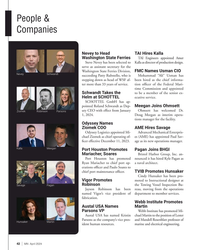 )
April 2024 - Marine News page: 42
)
April 2024 - Marine News page: 42is Mohammad “Ali” Usman has stepping down as head of WSF af- been hired as the chief informa- ter more than 33 years of service. tion of? cer of the Federal Mari- time Commission and appointed Schwandt Takes the to be a member of the senior ex- Helm at SCHOTTEL ecutive service. SCHOTTEL GmbH has ap- pointed
-
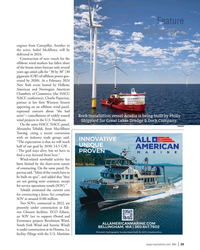 )
April 2024 - Marine News page: 29
)
April 2024 - Marine News page: 29engines from Caterpillar. Another in the series, Isabel McAllister, will be delivered in 2024. Construction of new vessels for the offshore wind markets has fallen short of the boom times forecast only several years ago amid calls for “30 by 30” (30 gigawatts (GW) of offshore power gen- erated by
-
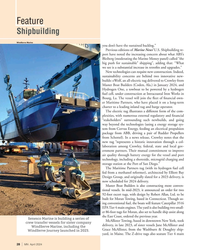 )
April 2024 - Marine News page: 28
)
April 2024 - Marine News page: 28Propellers from Schottel). In a news release, Crowley notes that the new tug “represents a historic innovation through a col- laboration among Crowley, federal, state and local gov- ernment partners. Their mutual commitment to improve air quality through battery energy for the vessel and port technology
-
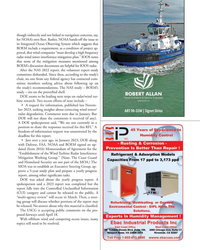 )
April 2024 - Marine News page: 25
)
April 2024 - Marine News page: 25for IOOS radar. After the NAS 2022 report, the volunteer expert study committee disbanded. Since then, according to the study’s chair, no one from any federal agency has contacted com- mittee members seeking advice about following up on the study’s recommendations. The NAS study – BOEM’s study – sits on
-
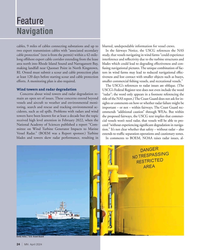 )
April 2024 - Marine News page: 24
)
April 2024 - Marine News page: 24commercial ? shing vessels, and recreational vessels.” The USCG’s references to radar issues are oblique. (The Wind towers and radar degradation USCG’s Federal Register text does not even include the word Concerns about wind towers and radar degradation re- “radar”; the word only appears in a footnote referencing
-
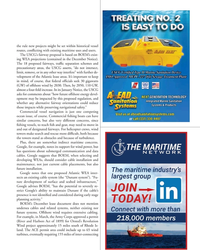 )
April 2024 - Marine News page: 23
)
April 2024 - Marine News page: 23, limit, remove, or in any other way interfere” with further de- velopment of the Atlantic lease areas. It’s important to keep in mind, of course, that federal of? cials seek 30 gigawatts (GW) of offshore wind by 2030. Then, by 2050, 110 GW, almost a four-fold increase. In its January Notice, the USCG
-
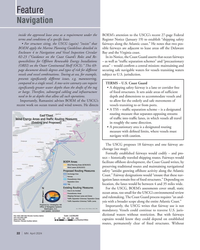 )
April 2024 - Marine News page: 22
)
April 2024 - Marine News page: 22Feature Navigation inside the approved lease area as a requirement under the BOEM’s attention to the USCG’s recent 27-page Federal terms and conditions of a speci? c lease. Register Notice (January 19) to establish “shipping safety • For structure siting, the USCG (again) “insists” that fairways along
-
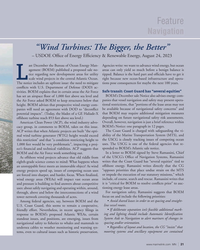 )
April 2024 - Marine News page: 21
)
April 2024 - Marine News page: 21, and this restriction” and that “a condition restricting height to the USCG is closely tracking issues of competing ocean uses. The USCG is one of the federal agencies that re- 1,000 feet would be very problematic”, impacting a proj- ect’s ? nancial and technical viabilities. ACP suggests that sponded
-
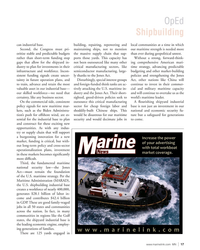 )
April 2024 - Marine News page: 17
)
April 2024 - Marine News page: 17OpEd Shipbuilding can industrial base. building, repairing, repowering and local communities at a time in which Second, the Congress must pri- maintaining ships, not to mention our maritime strength is needed more oritize stable and predictable budgets the massive supply chain that sup- than ever
-
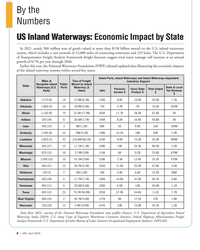 )
April 2024 - Marine News page: 8
)
April 2024 - Marine News page: 8state pro? les (Sources: U.S. Department of Agriculture Inland Waterways Study (2019); U.S. Army Corps of Engineers Waterborne Commerce Statistics; Federal Highway Administration Freight Analysis Framework; U.S. Department of Labor Bureau of Labor Statistics Occupational Employment Statistics; IMPLAN) 8
-
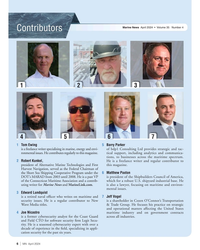 )
April 2024 - Marine News page: 6
)
April 2024 - Marine News page: 6is a freelance writer and regular contributor to president of Alternative Marine Technologies and First this magazine. Harvest Navigation, served as the Federal Chairman of the Short Sea Shipping Cooperative Program under the 6 Matthew Paxton DOT’s MARAD from 2003 until 2008. He is a past VP is president
-
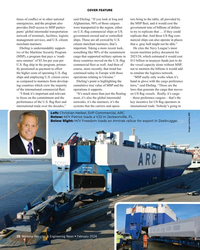 )
February 2024 - Maritime Reporter and Engineering News page: 28
)
February 2024 - Maritime Reporter and Engineering News page: 28COVER FEATURE times of con? ict or in other national said Ebeling. “If you look at Iraq and tors bring to the table, all provided by emergencies, and the program also Afghanistan, 98% of those cargoes the MSP ? eet, and it would cost the provides DoD access to MSP partici- were transported to the
-
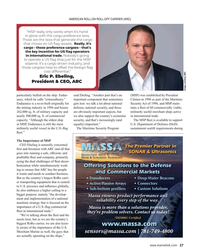 )
February 2024 - Maritime Reporter and Engineering News page: 27
)
February 2024 - Maritime Reporter and Engineering News page: 27AMERICAN ROLL-ON ROLL-OFF CARRIER (ARC) “MSP really only works when it’s hand in glove with the cargo preference laws. Those are the laws that generate the cargo that moves on US ? ag vessels. Really, it’s cargo – those preference cargoes – that’s the key incentive for US ? ag operators in internatio
-
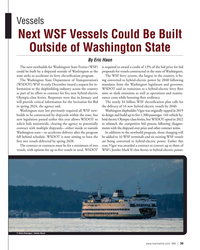 )
February 2024 - Marine News page: 39
)
February 2024 - Marine News page: 39Vessels Next WSF Vessels Could Be Built Outside of Washington State By Eric Haun The next newbuilds for Washington State Ferries (WSF) is required to award a credit of 13% of the bid price for bid could be built by a shipyard outside of Washington as the proposals for vessels constructed in the state of
-
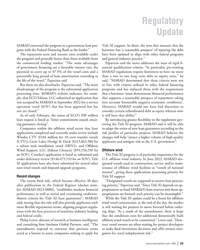 )
February 2024 - Marine News page: 33
)
February 2024 - Marine News page: 33Regulatory Update MARAD converted the program to a government loan pro- Title XI support. In short, the tests that measure that the gram with the Federal Financing Bank as the lender.” borrower has ‘a reasonable prospect’ of repaying the debt The repayment term and interest rates available under have
-
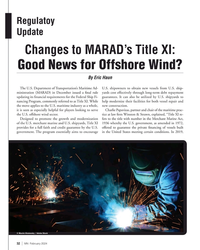 )
February 2024 - Marine News page: 32
)
February 2024 - Marine News page: 32(MARAD) in December issued a ? nal rule yards cost effectively through long-term debt repayment updating its ? nancial requirements for the Federal Ship Fi- guarantees. It can also be utilized by U.S. shipyards to nancing Program, commonly referred to as Title XI. While help modernize their
-
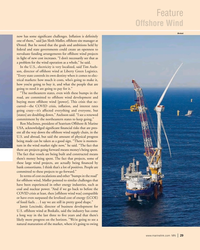 )
February 2024 - Marine News page: 29
)
February 2024 - Marine News page: 29. In? ation is de? nitely one of them,” said Jan Sloth Møller, offshore site manager at Ørsted. But he noted that the goals and ambitions held by federal and state governments could create an openness to reevaluate funding arrangements for offshore wind projects in light of new cost increases. “I
-
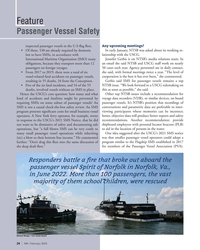 )
February 2024 - Marine News page: 24
)
February 2024 - Marine News page: 24Feature Passenger Vessel Safety Any upcoming meetings? inspected passenger vessels in the U.S-? ag ? eet. • Of these, 530 are already required by domestic In early January, NTSB was asked about its working re- law to have SMSs, in accordance with lationship with the USCG. International Maritime
-
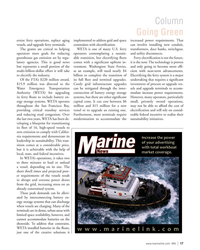 )
February 2024 - Marine News page: 17
)
February 2024 - Marine News page: 17or to upgrade an existing one. electri? cation and will rely on consid- and reducing road congestion. Over Furthermore, most terminals require erable federal incentive to realize their the last two years, WETA has been de- modernization to accommodate the sustainability initiatives. veloping a blueprint
-
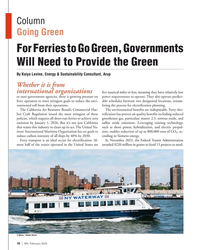 )
February 2024 - Marine News page: 16
)
February 2024 - Marine News page: 16intensity of all ships by 40% by 2030. cording to Siemens energy. Ferry transport is an ideal sector for electri? cation. Al- In November 2023, the Federal Transit Administration most half of the routes operated in the United States are awarded $220 million in grants to fund 13 projects to mod- © jjfarq
-
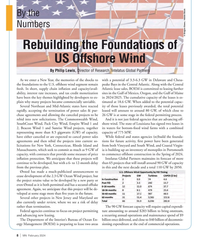 )
February 2024 - Marine News page: 8
)
February 2024 - Marine News page: 8& pur- leased will amount to around 80 GW, of which close to chase agreements and allowing the canceled projects to be 26 GW is at some stage in the federal permitting process. rebid into new solicitations. The Commonwealth Wind, And it is not just federal agencies that are advancing off- SouthCoast Wind
-
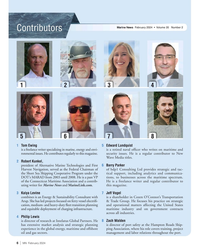 )
February 2024 - Marine News page: 6
)
February 2024 - Marine News page: 6New Wave Media titles. 2 Robert Kunkel, president of Alternative Marine Technologies and First 6 Barry Parker Harvest Navigation, served as the Federal Chairman of of bdp1 Consulting Ltd provides strategic and tac- the Short Sea Shipping Cooperative Program under the tical support, including analytics
-
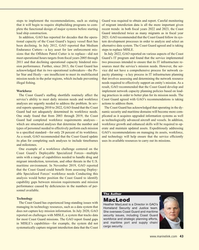 )
January 2024 - Maritime Reporter and Engineering News page: 43
)
January 2024 - Maritime Reporter and Engineering News page: 43steps to implement the recommendations, such as stating Guard was required to obtain and report. Careful monitoring that it will begin to require shipbuilding programs to com- of migrant interdiction data is all the more important given plete the functional design of major systems before starting recent
-
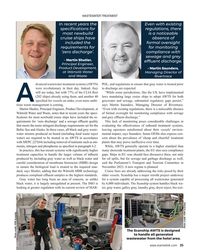 )
January 2024 - Maritime Reporter and Engineering News page: 35
)
January 2024 - Maritime Reporter and Engineering News page: 35WASTEWATER TREATMENT In recent years the Even with existing speci? cations for regulations, there most newbuild is a noticeable cruise ships have absence of included the formal oversight requirements for for monitoring ‘zero discharge’. compliance with sewage and grey – Martin Shutler
